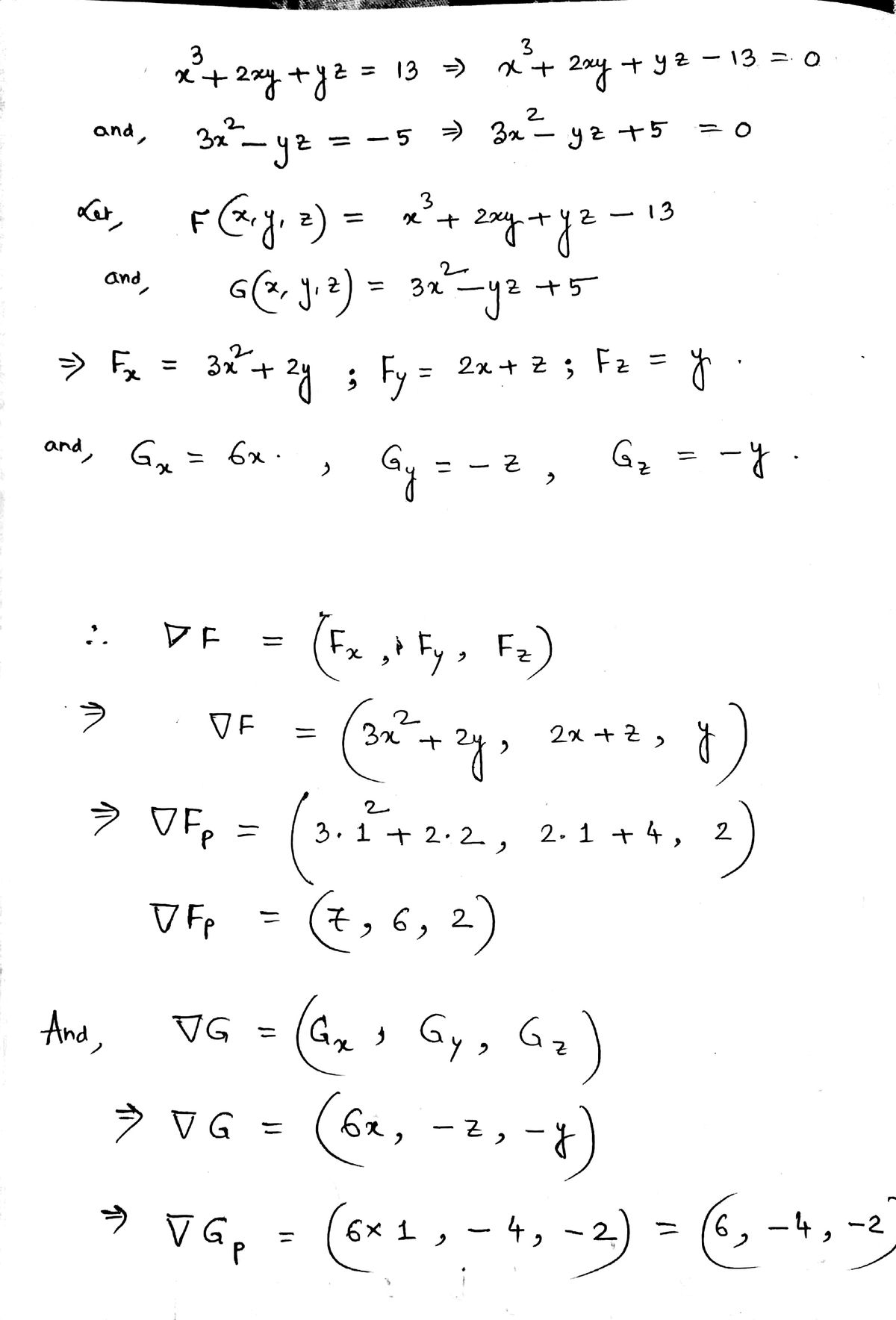Let C be the curve obtained by intersecting the two surfaces x³ + 2xy + yz = 13 and 3x² − yz = −5. Find the parametric equations of the tangent line to C at P = (1, 2, 4). It is known that if the intersection of two surfaces F(x, y, z) = 0 and G(x, y, z) = 0 is a curve C and P is a point on C, then the vector v = VFpx VGp is a direction vector for the tangent line to C at P. (Use symbolic notation and fractions where needed. Enter your answers as functions of parameter t in a form r(t) = = (x(t), y(t), z(t)) = ro + vt, where ro is the corresponding coordinate of point P.) x(t) = y(t) = z(t) =
Let C be the curve obtained by intersecting the two surfaces x³ + 2xy + yz = 13 and 3x² − yz = −5. Find the parametric equations of the tangent line to C at P = (1, 2, 4). It is known that if the intersection of two surfaces F(x, y, z) = 0 and G(x, y, z) = 0 is a curve C and P is a point on C, then the vector v = VFpx VGp is a direction vector for the tangent line to C at P. (Use symbolic notation and fractions where needed. Enter your answers as functions of parameter t in a form r(t) = = (x(t), y(t), z(t)) = ro + vt, where ro is the corresponding coordinate of point P.) x(t) = y(t) = z(t) =
Calculus: Early Transcendentals
8th Edition
ISBN:9781285741550
Author:James Stewart
Publisher:James Stewart
Chapter1: Functions And Models
Section: Chapter Questions
Problem 1RCC: (a) What is a function? What are its domain and range? (b) What is the graph of a function? (c) How...
Related questions
Question

Transcribed Image Text:Let C be the curve obtained by intersecting the two surfaces x³ + 2xy + yz = 13 and 3x² − yz = −5. Find the parametric
equations of the tangent line to C at P = (1, 2, 4).
It is known that if the intersection of two surfaces F(x, y, z) = 0 and G(x, y, z) = 0 is a curve C and P is a point on C, then the
vector v = VFpx VGp is a direction vector for the tangent line to C at P.
(Use symbolic notation and fractions where needed. Enter your answers as functions of parameter t in a form
r(t) = = (x(t), y(t), z(t)) = ro + vt, where ro is the corresponding coordinate of point P.)
x(t) =
y(t) =
z(t) =
Expert Solution
Step 1

Step by step
Solved in 2 steps with 2 images

Recommended textbooks for you

Calculus: Early Transcendentals
Calculus
ISBN:
9781285741550
Author:
James Stewart
Publisher:
Cengage Learning

Thomas' Calculus (14th Edition)
Calculus
ISBN:
9780134438986
Author:
Joel R. Hass, Christopher E. Heil, Maurice D. Weir
Publisher:
PEARSON

Calculus: Early Transcendentals (3rd Edition)
Calculus
ISBN:
9780134763644
Author:
William L. Briggs, Lyle Cochran, Bernard Gillett, Eric Schulz
Publisher:
PEARSON

Calculus: Early Transcendentals
Calculus
ISBN:
9781285741550
Author:
James Stewart
Publisher:
Cengage Learning

Thomas' Calculus (14th Edition)
Calculus
ISBN:
9780134438986
Author:
Joel R. Hass, Christopher E. Heil, Maurice D. Weir
Publisher:
PEARSON

Calculus: Early Transcendentals (3rd Edition)
Calculus
ISBN:
9780134763644
Author:
William L. Briggs, Lyle Cochran, Bernard Gillett, Eric Schulz
Publisher:
PEARSON

Calculus: Early Transcendentals
Calculus
ISBN:
9781319050740
Author:
Jon Rogawski, Colin Adams, Robert Franzosa
Publisher:
W. H. Freeman


Calculus: Early Transcendental Functions
Calculus
ISBN:
9781337552516
Author:
Ron Larson, Bruce H. Edwards
Publisher:
Cengage Learning